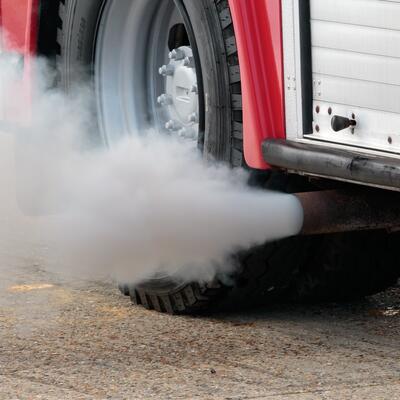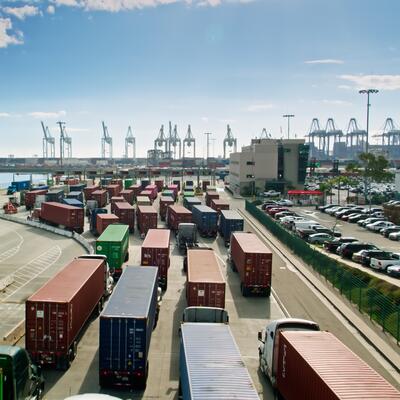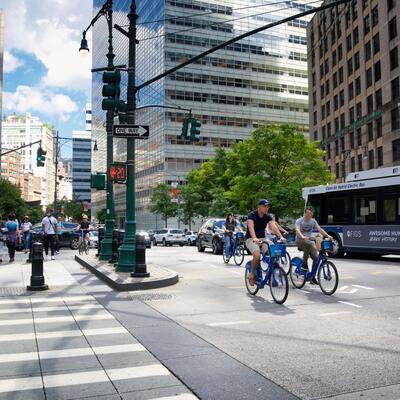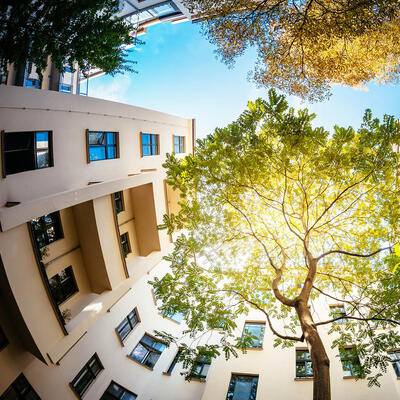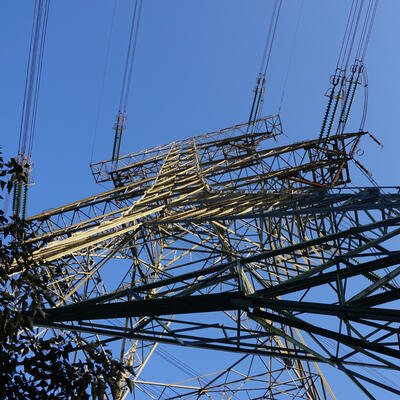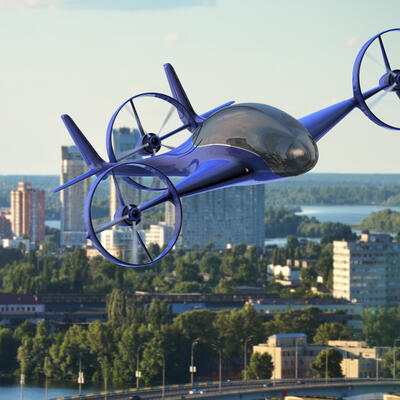
How a Manufactured Car Culture Blocks Transit
Guests

Peter Norton

Eric Goldwyn

Amanda Eaken
Summary
Unless you live in one of the few dense, urban parts of the country, you probably rely on a car to get around. That culture of car dependency feels natural, because most of our cities have been built for cars, rather than pedestrians, bikes or dedicated mass transit. But it wasn’t always that way.
A hundred years ago, people used streets for just about anything, provided it wasn't too obnoxious or too dangerous, says Peter Norton, associate professor at the University of Virginia and an expert on transportation history.
In his book, Fighting Traffic, Norton explains that even as the “motor age” unfolded, Americans resisted car dominance for a long time.
“The objections ranged everywhere from, ‘this is an obnoxious nuisance’ to ‘this is killing people.’ And it really was,” Norton says. “It felt not only like a danger and a nuisance, but also like an unfairness, you know, ‘a privileged class is ruining or endangering street use for everyone else.’”
Norton says the narrative of American’s so-called “love affair with cars” has been created and sold by car companies like General Motors, who originated that catchphrase. Part of their effort over decades was to redefine transportation mobility and access by cars.
“In other words, until you have everything accessible by car, it’s not accessible. And perversely, when you make something more accessible by car, you almost inevitably make it less accessible by everything else,” Norton says.
That way of thinking has become embedded in transportation funding and planning models that continue today. Eric Goldwyn is co-founder of the Transit Costs Project, which compares building costs for public transit in cities around the world. He says there are several reasons why projects in the United States tend to cost a lot more than elsewhere.
“One thing that we see in the States is that there is a lack of in-house capacity at transit agencies to do the hard work of planning a project and getting public buy-in all sort of lined up in time,” he says. Regulation and labor costs also play a role, but Goldwyn says there’s less public and political appetite for projects here because transit isn’t the main transportation method for the majority of people. If we really want to make it mainstream, he says, we need to invest in regular, frequent and dependable public transit.
“Unless you make the car less desirable or less effective at getting people where they need to go, then transit’s never really going to win that battle. Transit really needs to be that anywhere to anywhere transportation service.”
Getting more people out of cars could do a lot to help slow climate disruption.
Amanda Eaken is director of transportation for the Bloomberg American Cities Climate Challenge at the Natural Resources Defense Council, where she has been working to help cities decarbonize their transportation. She says in many places, the pandemic has ushered in a rethinking about what streets are for--a place to walk, dine out and hear music, instead of strictly to move cars. In the last couple years some cities have passed new tax measures to fund transit, created bus rapid transit lanes or bike infrastructure or launched an electric vehicle car sharing program.
Eaken says both President Biden’s infrastructure legislation and the transportation reauthorization bill are “phenomenal opportunities” for the federal government to make big investments in transit infrastructure and operations. Her group is seeking parity of funding between cars and transit.
“Traditionally, the federal government, through the transportation reauthorization bill, has put about 80% of the money towards roads and highways and only a fixed 20% to transit. We’re calling for a leveling of that playing field,” Eaken says.
Related Links:
Transit Costs Project
Fighting Traffic
Autonorama
Full Transcript
Greg Dalton: How can we make public transit work in American cities? Climate One’s empowering conversations connect all aspects of the climate emergency. I’m Greg Dalton. The U.S. House of Representatives recently passed a $549 billion-dollar measure that would make it harder for states to build new highways and incentivize transit instead. The INVEST in America Act would be a big shift away from the highway habit of the last 70 years. Unless you live in a dense, urban part of the country, you probably rely on a car to get around. That culture of car dependency feels natural, because most of our cities have been built for cars, rather than pedestrians. But it wasn’t always that way.
Peter Norton is associate professor at the University of Virginia and an expert on transportation history. Climate One’s Ariana Brocious spoke with him about how America’s car culture was actually manufactured, and how proponents of autonomous cars are repeating a tried and true sales pitch.
Ariana Brocious: So, I think many of us have a somewhat romanticized view of American car culture that owning and driving cars is part of the fabric of our identity. But as you explain in your book Fighting Traffic, cars weren’t the default option in the early part of the 20th century. So, how did Americans use and perceive streets before the automobile age?
Peter Norton: In a lot of ways it was sort of the opposite of what we expect today. In other words, everything but cars were sort of expected and welcome. A street was a space for just about anything provided it wasn't too obnoxious or too dangerous. And by both of those standards the car when it was new when they first started to appear in large numbers actually seem to be the thing that was breaking the prevailing social norms and that is it was, you know, relatively dangerous and kind of obnoxious to other people.
Ariana Brocious: Your book highlights how a lot of residents of American cities actually resisted and protested the dominance of cars. So, what were some of those reasons for that?
Peter Norton: The objections ranged everywhere from, you know, this is an obnoxious nuisance to this is killing and it really was large numbers of people. People who don't even drive most of the people who are getting injured or killed were people who never drove a car and didn't use a car. And so, there is a perception that this was a real inequity. if you're trying to cross the street or trying to get to a streetcar because the streetcar is first of all they were in practically every city even small cities and they were right in the middle of the street. The tracks went right down the center, which meant that to board a streetcar or to get off the streetcar and go to your destination you were crossing the street just about anywhere. And so, it felt not only like a danger and a nuisance, but also like an unfairness, you know, a privileged class is ruining or endangering street use for everyone else.
Ariana Brocious: And you talk about this sort of invented concept of jaywalking. Can you explain that?
Peter Norton: Yeah, so, I mean the problem was as far as most people were concerned that this newcomer the intruder the automobile was making it harder to use the street safely. But that way of looking at it kind of limited what cars could ever be in cities. So, the people who wanted to sell cars in cities and the people who already owned them and belong to automobile clubs and the automobile dealers and so on. They had to get together and say, you know what, actually it's normal to drive a car in a city street and that was a tough claim to make 100 years ago. It was a tough claim to argue that streets are a legitimate place for driving fairly fast. And to make that argument they had to find a way to challenge people who felt like streets are for walking in. So, the people who wanted a future for cars in cities organized and they put up a message and the message were, you know what times, this is the 20th century, folks. This is the motor age, and you need to get with the times. And if you're not with the times, then you're a throwback you're out of touch, you're out of step with the era you are a jay. Now the word jay doesn't mean very much to us anymore, but 100 years ago it meant something like rube or hick or hayseed. And it was a way of putting jay together with another word was really common and a jay town for example, was a town with like no theater, no amenities. So, a jaywalker was like somebody who hadn't kept up with the times stuck in the 19th century; it was a term of ridicule to try to make people accommodate automobiles instead of resisting them.
Ariana Brocious: That’s really fascinating. I mean, it sounds a lot like kind of the more contemporary example of making people feel responsible for their own carbon footprint and also when it comes to things like plastics that we have to recycle it's all us, when in fact individual decisions are necessarily the root of the problem.
Peter Norton: Yeah, so I mean the jaywalker story is a nice little micro example of a much bigger strategy of reframing. Reframing so as to normalize things like car dependency and car domination and denormalized everything else. So, one of the expressions that says we’re a car culture is a little line that sounds like folk wisdom and the line is that the Americans have a love affair with the automobile. And I heard that when I was quite young and I figured this is just an expression. So, I was quite surprised when I learned that that expression was invented by General Motors as a way of promoting the car culture story the car culture account. Because it’s a really wonderful way of sidestepping the issue does car dependency makes sense because it shifts it from a question about what makes sense to a question about what do we love? And love is not about what makes sense, right, love is blind love will find a way and if we’re a free country then we defer to what people love we don't judge it.
Ariana Brocious: So, we’ve touched on the role of car companies themselves to market automobiles and kind of reframe streets as the place for cars. What's been the role of the federal government indicating how we design cities and interstate highways leaning toward this preference of individual cars rather than trains or buses?
Peter Norton: Very interesting question. I mean for one thing to get the federal government involved at all in anything like roads and streets was a tall order just 100 years ago. Because you know under the Constitution road building and maintenance is primarily a state or a local responsibility. And for a federal government to be spending federal tax money on a road used to look like a real abuse of federal power. This began with federal responsibility for delivering the mail and under the Constitution that is a federal responsibility. So, they could justify some money for major roads that could serve the postal network. But you know that doesn't give us the present. For the interstate highways that you mentioned another federal responsibility they could invoke was defense. And that's a major reason why the interstate highways were framed as a defense measure. Oddly, the main defense justification offered was that in an era of nuclear war you need a way to evacuate cities quickly and we know from hurricanes, you know, interstate highways have actually done a pretty poor job at evacuating people from cities. So, it's clearly a failure from that point of view. A really big angle though to your question is how we redefined transportation mobility and access. And we did that with the assistance of the automobile companies and related industries who began to work very hard going back to the 1920s and 30s to redefine access as accessed by car. In other words, you know, until you have everything accessible by car it’s not accessible. And you know perversely when you make something more accessible by car, you almost inevitably make it less accessible by everything else.
Ariana Brocious: So, another aspect of that boom of construction was that many freeways were built through committees of color and often destroyed vibrant neighborhoods. So, what's the racial legacy of that interstate highway system and the car culture that emerged in postwar America?
Peter Norton: This is a really horrific you know truth that we've been extremely slow to face. I mean it's always been faced by a fraction of the population, but it hasn't been in the mainstream media very much until quite recently. But yeah, even before the interstate highway says we know that really began in ‘56 already, you know, for well over a decade roads motor thoroughfare had been plowed right through communities of color. And this is sometimes oversimplified as purely a dollars and cents phenomena in other words, this is where you could get the land, the cheapest and therefore that's where the routes went of course had everything to do with political power as well. In a really disturbing way this got paired with another federal highway project. The urban renewal, you know, beginning with the Housing Act of 1949, which offered federal money ostensibly to rehabilitate blighted urban districts. Really what they were calling blighted urban districts could more accurately be called affordable urban districts and also could be more accurately called urban districts where people of color could get a rental or get a mortgage which you know was not true most places. And in city after city after city these projects just totally devastated neighborhoods on paper urban renewal was supposed to be providing good low-income housing, but it's a well-known fact that urban renewal removed more housing stock than it ever replaced. Most of the land that was redeveloped or as redeveloped for so-called high-value purposes like convention centers high rent apartment buildings, retail, civic centers, stadiums and also highways. And so, it was a real smash and grab and it went hand-in-hand with underfunding of transit. So, at the same time the provision of expressways for suburban commuters were overwhelmingly white people was made a federal priority with federal money. Transit was reduced to a charity case that you offer a pittance to out of a benevolent interest in the well-being of everyone you've just de-housed. And so, these things are connected the transit the degradation of transit urban renewal and the expressways and suburbanization such that it's a real systemic abuse of the American city that went on for decades and that we are living in the legacy of today.
Ariana Brocious: Yeah, and let's bring that up to today. So, what are the incentives that continue to lead cities to invest in more lanes and roadways over transit over rehabbing or really investing in public transit?
Peter Norton: Well, I think I will start answering that question by going back a little bit because the massive federal highway money that was unleashed following in the 1956 act was to be money for roads and roads only 90% of that cost was picked up by the federal government 10% by the states and cities that didn't want these projects just didn't get the money. It wasn’t like you could get the money and say well, we’ll put it into buses and so on. Thereafter there was a long struggle. Why don’t we let cities have some discretion over how this money is spent? The pro-roads pro-automobile industry people would say no, this money came from gasoline taxes so it should go to roads only. By the 70s that argument was starting to change, you know, OPEC oil embargo as part of this in ‘73 ecology movement was part of it some degree, the civil rights movement was part of it. And by ’74, you could as a city take some of that money and put it into transit but not very much. But what this set us up for is the present where we still have a default assumption that money for federal transportation projects and cities is highway money, a certain fraction is set aside for transit mostly for capital projects not to operate them. And to this day we define congestion primarily as insufficient road capacity rather than a misallocation of resources when you are committed to providing a congestion free driving experience for the least spatially efficient mode of transportation ever invented, this is what you get, you know, you find yourself digging a hole and just digging deeper into the hole the harder you dig.
Ariana Brocious: I’m talking with Peter Norton, Associate Professor of History at the University of Virginia, author of Fighting Traffic and a forthcoming book Autonorama. So, I wanted to ask about this new book coming out because it challenges the idea of autonomous vehicles as the solution to our problems. And the books description has a quote that says, “We are once again being sold car dependency in the guise of mobility.” So, can you tell us a bit about that?
Peter Norton: Yeah, so you can't have missed I'm sure you know your listeners can’t have missed the selling of autonomous vehicles as the future of transportation at least a big part of the future and may be the whole thing that they are going to these robotic cars are going to deliver us from congestion they’ll be more sustainable somehow and they'll be above all safer. That’s how they’ve been sold. Now, this is a high-tech car solution that we've been getting sold now for about 85 years. If you go back to 1939, General Motors was showing us a future at that time it was the city of 1960, which was going to be a congestion free, crash free paradise. And it didn't actually have to work because it was just a model. It didn't have to be realistic, but it did have to be credible and to make it credible the message was technology is going to make it possible. And now the version that's being sold is based on machine learning and artificial intelligence sensors, lidar, radar, optical sensors, network systems. All these things are supposed to make car dependency work as if the deficiency has been technology. But really the deficiency has been car dependency. In other words, it's not that we don't have enough technology to make car dependency finally work it’s the car dependency itself doesn't make sense. It's not like we can't have cars I think cars could be wonderfully useful tools in a bigger tool set. But we need to similarly realize that car dependency is an option. It was never a good option and technology can't make it a good option. And my fear is that distracting us from the wonderful things we can do right now that are affordable, more sustainable, more feasible, more practical, more enjoyable, more healthful, more efficient.
Ariana Brocious: So, I think I know your answer to this, but then do electric vehicles offer any solutions certainly from a climate perspective, they do, right, from an emission standpoint. But in a car dependence world maybe not?
Peter Norton: You know, electric vehicles are going to be essential, but we’re gonna have to find a way to do it where we don't need as much driving as before. Of course, all those electric vehicles would have to be charged right now we have something like 20% of the US power grid from renewables on a good day and that's defining renewables pretty generously. We need to get that number higher. As far as the batteries go there's one really, it’s sort of a painful, but also practical lesson from the past. You don't have to have batteries to have an electric vehicle. Every city in America big, medium and almost all the small ones as well had electric vehicles, 100 years ago with no batteries, they are called streetcars. That's an example that you can actually have electric vehicles that don't need the batteries that would be a big plus. You can have electric buses that don't need batteries too if they can connect to an overhead power supply. So, that's a possibility as well. I think battery-powered electric vehicles are going to be necessary too but they’ll have to be part of a mix where people can walk to destinations, cycle to destinations on a regular bike or on an e-bike take the bus and take rail. Because those things can all serve our needs too, all of the transit buses and rail are often criticized as expensive, but we have to be, you know, you don't say anything about cost unless you’re comparing. And compared to car dependency which is unfathomably expensive they’re actually a pretty good deal. So, I think we really do have some good choices.
Ariana Brocious: I hope so. I've been speaking with Peter Norton, Associate Professor of History at the University of Virginia and author of Fighting Traffic: The Dawn of the Motor Age in the American City and forthcoming book Autonorama. Thank you so much Peter for talking with us on Climate One today.
Peter Norton: It's been my pleasure, Ariana, thank you very much.
Greg Dalton: You’re listening to a Climate One conversation about how our relationship with cars developed and why it’s so hard to get out of them and into public transit. If you missed a previous episode, or want to hear more of Climate One’s empowering conversations, subscribe to our podcast wherever you get your pods. Coming up, what we can learn from other countries that do transit well:
Eric Goldwyn: Investment in bus service really does pay dividends. If a bus is coming every 10 minutes every five minutes during the peak or something like that you can really sort of rely and depend on it.
Greg Dalton: That’s up next, when Climate One continues.
Greg Dalton: This is Climate One. I’m Greg Dalton. We move now to why we’re so bad at building cost-effective, reliable public transit in America. Eric Goldwyn has explored that question through his research at the NYU Marron Institute of Urban Management. He says there are several reasons, one of which is the funding model.
Eric Goldwyn: So, often times since projects are so expensive you need to get a lot of different people contributing money to the federal government, a local government of some sort, a transit agencies so on and so forth and sort of putting together all of that capital is just a difficult process. And the other part of it right is that throughout the country so few people rely on transit. You know, in Kansas City or in Oklahoma City where 90% of people drive or carpool to work every day it’s just a much more, you know, a much greater lift. And so, it creates a lot of opportunities for veto points, you know, public interference, lawsuits, things of that and also change of administration, right, if you sort of had a champion in the governor's office or the mayor's office and then you know here she subsequently leaves office that also can create a number of hiccups. And we've seen that in a number of projects.
Greg Dalton: You also say that it's how the transit projects are sold to the public they’re often sold to reduce congestion that doesn't happen so people say, so why do we do it?
Eric Goldwyn: Right, that’s absolutely that’s another part of it, right, is that the benefits oftentimes don't sort of pan out. And so, the other part of it right is that oftentimes the projects are sold to you know to be at a certain budget and done on a certain date and then oftentimes they are overbudget they’re delayed in delivery and then fewer riders than projected. So, yeah, the public appetite diminishes and there's less confidence in the ability to deliver on sort of these sanguine promises.
Greg Dalton: You’re the cofounder of the Transit Costs Project comparing cost of building projects in different countries. Pretty interesting reading to look at the cost in Cairo and all these different places. Why is it so more expensive to build transit in the US as opposed to other places?
Eric Goldwyn: So, with my colleague Alon Levy, we've been looking at cost,, and it’s about 60 countries now over 600 projects. One thing that we see in the states is that there is a lack of in-house capacity at transit agencies to sort of do the hard work of planning a project and sort of getting public buy in all sort of lined up in time. Other places in the world I'm thinking of sort of northern Italy, where we’re looking at some stuff more closely. Projects in Spain, projects in the Nordic countries, they do a lot of the design and planning work sort of in-house and sort of they then bid out to someone to construct the project at the very end rather than sort of create a long process where you sort of announce, you have interest and idea you bring in a bunch of consultants to sort of do the design and then you respond to public comments then you have to have the consultants redesign the project then you have to jump through a bunch of regulatory hurdles, then you finalize your design. Then you have to bid it out all over again to a final build contract, So, there are a lot of sort of steps and hurdles along the way that we have put up in front of our projects.
Greg Dalton: Often in the United States we hear it’s because of regulation environmental regulations because of unions. Are those real obstacles, regulations and unions that drive up the US cost?
Eric Goldwyn: Sure. I think some regulations some of the sort of NEPA process which is sort of an environmental process. Part of that, you know, might contribute absolutely, but it's important to note, right, it’s not as if in other countries they don't have environmental regulations, but you know costs in sort of Denmark in Stockholm, in Switzerland the costs are, you know, under control in those places. And there’s no argument that their environment is much worse than ours or something like that. On the labor side of things, we do see that there are issues with sort of, you know, hourly wages vary from place to place no doubt. But in our data, we do try to adjust for what we use as a PPP conversion to adjust for local conditions.
Greg Dalton: That’s purchase price parity. PPP is purchase price parity.
Eric Goldwyn: Exactly, right. So, that, you know, there are some comparing across projects. So, like Turkey is a country that we've looked a lot at and, you know, they build things very cheaply and it's true their labor costs are much lower even after adjusting for that PPP conversion. But another thing that we see is that there's a lot of staffing and not just at the sort of labor level but at the white-collar oversight level, right. So, you have lots of consultants who are contracted with to sort of make sure that things are going smoothly and when we talk to planners and construction workers and contractors in other parts of the world, they’re always blown away by how many just different people are involved in these projects.
Greg Dalton: Okay. Tell us about your case study at Boston's Green Line Extension where a simple light rail extension ended up with stations that cost more than 100 times the initial estimates. What can we learn from that?
Eric Goldwyn: Right. So, I think one of the big things that we see and this is true in a number of cities in America is that stations are very expensive when you build them to be much more than a place where someone waits for a train to come. If they have sort of elaborate plantings and they have two levels, elevators, escalators, you know, if their community building projects in addition to transit projects they end up getting sort of larded up with sort of community driven perks and things of that sort that are a little bit sort of orthogonal to what a transit project is. And in the case of Boston that's absolutely what happened, right. So, the initial design was essentially a weather shelter sort of, you know, just a roof and then a bench and then ramps, you know, for ADA access buildings stuff like that. And then it grew into sort of bespoke unique architecture that blends into the community and makes a real place, you know, native plantings, to welcome you as you enter the station. Two floors, bathrooms for patrons and then space for MBTA staff and stuff like that. So, a lot of things just got added on, and all those added things just cost money. So, a little bit of background on the green line is that it was supposed to extend one more station to the north Mystic Valley Pkwy. and because of the cost issues they just couldn't afford to take it to that next station.
Greg Dalton: Are there class and racial dimensions to support for public transit and who rides public transit? Again, this sort of New York, Boston they’re kind of the exception, right. But overall is there are a kind of race and class connotation therefore, why those systems don't get the kind of support because they’re for the underclass?
Eric Goldwyn: Oh, I think that's absolutely because I think, you know, New York is a real outlier in that the average subway rider I believe this is right is slightly richer than the average New Yorker. But the average bus rider is poorer than the average New Yorker likely older than the average New Yorker likely a minority likely less educated. So, all of the sociodemographic things that you should or alluding to is much more likely to find on the bus and on the subway on New York. But then yes, absolutely when you get out of the city of New York it’s very stark how divided bus lines are versus sort of the rest of the population in cities. And cities like Oklahoma City where 90% of people drive or carpool to work and maybe it’s even higher now. The only people left who are to ride the bus are people who just can’t afford a car and I think that's the other problem, right. Car ownership is aspirational, right, most people are sort of looking forward to the day that they can sort of buy a car and not be stranded on the bus. And there’s a lot of great work I have a colleague Nick Klein at Cornell and he’s done a lot of work on sort of just how many hoops and financial hardships people will take on to own a car and it's absolutely worth it. Even if it's like a high interest loan it’s like it means they have more access to jobs it means they’re more likely not get fired for being late when they go to work. They can go to medical services they can pick up their kids get them to school. Like all these things are available to you once you have access to a car in a place that has pretty much a nonexistent bare-bone transit system.
Greg Dalton: Well, a lot of cities don't have those transit systems and lot of it is really the density isn't there. A lot of this gets to land use, which I know you also study with single-family homes scattered across sprawling landscapes planners face well, you know, do we build up and increase cost or do we build out, you know. So, how does land planning and land use come into this and density?
Eric Goldwyn: Yeah, so I think land-use is a big part of this. I would push back slightly on the sort of density determinism. I think there are examples of I'm thinking of sort of suburban Toronto where they run very frequent bus service in, you know, single-family neighborhoods not sort of like 1 acre lots, you know, I’m not staying there. And they found that, you know, investment in bus service really does pay dividends and people take it into downtown because parking is hard to come by when you get downtown. And you can sort of if a bus is coming every 10 minutes every five minutes during the peak or something like that you can really sort of rely and depend on it. It's not sort of a burden there are so many places in this country where bus service stops at 6 PM doesn't run on the weekend. It runs once an hour, you know, like that’s not a serious transit system like that's always gonna be sort of a struggle and an uphill battle. But to get to your point, one thing that is mind-boggling is when you look at some of these new
light rail projects in Texas or in California. You see them just cruising by parking lots, you know, and it’s like that is so frustrating. You really do want to like take advantage of the transit infrastructure investment and rethink your land-use allow for some density allow for some building along that corridor so you have sort of a natural population to draw from.
Greg Dalton: Eric Goldwyn is Assistant Professor at the NYU Marron Institute of Urban Management and Cofounder of the Transit Costs Project. Let’s talk about Los Angeles. You kind of push back on the density determinism. Los Angeles is very interesting to me as the pinnacle of car culture yet, in 1990 embarked on a light rail system that now carries about 150,000 riders a day. What did LA do right and what can be learned from LA which is very car centric and yet the light rail in LA goes to the ocean is going to the airport it goes up into Burbank and the San Fernando Valley it’s getting around.
Eric Goldwyn: So, I think LA I think the biggest thing that they’ve done is they’ve sort of just made the commitment that they’re gonna build a lot of transit. And that's something that isn't really the case in most American cities. You know, Seattle is another city that has done some interesting things with its buses and it's also expanding its light rail offerings and things of that sort. But that’s a big part of it, you know, previous mayor Antonio Villaraigosa talked about the subway to the sea constantly. Los Angeles they’ve done some things right, absolutely, but, you know, they still make certain fatal flaws in the design of stuff, you know, they I think running light rail in the medians of highways and things of that sort. What you see in a lot of American it goes to your point about land use just sort of like it's a stultifying environment that you’re building through how do people access it, it creates a lot of problems.
Greg Dalton: Yeah, it goes a lot of places, but isn’t necessarily go faster than the traffic. We’ve seen a big shift to more remote work during the pandemic. In a recent article the New York Times made the point that have just a small sustained change in the number of people traveling at rush hour could dramatically reduce the need to build up capacity for those peak times. So, what do you think about flattening the curve of transit demand and would that really help?
Eric Goldwyn: So, I think the lesson I would take away from that is what I'd like to see is more of a reduction of sort of the emphasis I should say, a deemphasis on sort of peak service in a movement to sort of just all-day service, right. So, when I look at, if you look at a city like Rome or Mexico City and how they sort of provision transportation services. I’m gonna make this up a little bit but starting at six in the morning they just start running the buses the light rail the trams the trolleys the subways whatever. And then they keep a very healthy sort of frequency say every five minutes every 10 minutes until 8 o'clock at night or something like that. And that way you sort of can account for it draws people in who aren’t necessarily commuting for work, right. So, like that peak demand issue that you're alluding to because you’ve smooth that out. So, you need all the service just at that time. But you do still create the opportunity that people can depend on and rely on transit at any time of day. And I think that’s sort of the key.
Greg Dalton: Yeah, and post-COVID people wanna travel when it's less crowded. Congress is weighing some huge measures dealing with infrastructure and transportation this summer. What priorities do you hope make it into those bills and can make the shift from roads to transit as we think about climate?
Eric Goldwyn: Well, I think the big thing is you want to see sort of an inversion in where the dollars are going transit to roads. One of the things that’s most striking when I look across the landscape of international cities is a city like Milan, you know, instead of 20% of the money going to roads. I mean 20% of money on transit and 80% going to roads, it’s the opposite, it’s 80% going to transit, 20% going to roads. And I think that is just unfathomable in any American context. But I think that's really the direction we need to be going in, because unless you make the car sort of less desirable or less effective at getting people where they need to go then transit’s never really going to win that battle. Transit really needs to be sort of that anywhere to anywhere transportation service.
Greg Dalton: Eric Goldwyn, from the NYU Marron Institute of Urban Management. Thanks for coming on Climate One.
Eric Goldwyn: Thank you very much.
Greg Dalton: Some U.S. cities are getting serious about their transit systems. Climate One contributor Aubrey Calaway brings us the view from Houston, where transportation changes are underway.
Aubrey Calaway: I’m here in central Houston, at a metro rail stop in the Texas Medical Center. It’s 5pm, and doctors, nurses, and hospital staff are streaming onto the platform to wait for the next train. After a short trip on the light rail, we arrive at the transit center. I’m waiting for an express bus to the Southwestern edge of Houston when I meet Dia, a hospital employee.
Aubrey Calaway: Do you take this route every single day?
DIA: No, I just started taking it because my car is in the shop, but I used to before.
Aubrey Calaway: Riding transit has added an extra fifteen minutes to Dia’s normal commute, but she doesn’t mind.
DIA: Yeah, it’s a good experience. With this one I like that it takes me straight to the park-and-ride. Yeah, so I like that.
Aubrey Calaway: The bus arrives, and it’s a straight shot to the Missouri City Park and Ride, where the other passengers spill out of the bus and into their own waiting vehicles. They’ll head towards any number of Houston’s prosperous, fast-growing suburbs. Because for many users, the city’s transit still works best when combined with a car. Houston is huge, covering an area half the size of Rhode Island. And for decades, the city has been built for and around the car. Twelve lane highways, sprawling growth, and land-use regulations that prioritize free parking over sidewalks and bike lanes have defined the way Houstonians move and live. That began to change in 2015 when Houston METRO replaced its old bus system with a brand-new grid of routes overnight. Improvements like expanded light rail and more frequent bus stops made transit a more convenient option for residents of largely white and wealthy neighborhoods within the city’s core. In contrast, only 1 in 3 affordable Houston dwellings is located near high-quality transportation. Combined with a lack of job opportunity in these neighborhoods, many low-income communities, especially immigrant and communities of color, have been left disconnected and car-dependent. Houston has now arrived at one of the most significant turning points in its mobility infrastructure in decades.
METRO ANNOUNCER: METRO is ready to move you into the future at the speed of life
Aubrey Calaway:In November 2019, Houston voters passed a $7.5 billion dollar bond referendum to support the MetroNext Moving Forward Plan. The package includes major upgrades to the transit system, including the city’s first Bus Rapid Transit line.
TV ANNOUNCER: Now to new developments in a controversial construction project, a plan to move I-45 from one side of downtown Houston to another
Aubrey Calaway: Most recently, the U.S. Department of Transportation and Harris County officials halted a $9 billion state plan to rebuild and widen highway I-45, a huge thoroughfare in the city’s core. Local activists have opposed the expansion for years, over concerns about increased air pollution and the displacement of black and Latino neighborhoods.The future of the 1-45 expansion is still unclear, and it remains to be seen whether MetroNext transit upgrades will truly address mobility inequities in the city. For Climate One, I’m Aubrey Calaway in Houston.
Greg Dalton: Coming up, how the pandemic altered some thinking about urban design:
Amanda Eaken: There’s been a bit of a re-envisioning of what street is even for where maybe previously people thought about a street as a place to move cars. And now they’re starting to think about street as places to gather with their neighbors or teach their child how to ride a bike or simply just take a walk at the end of the day. (:17)
Greg Dalton: That’s up next, when Climate One continues.
Greg Dalton: This is Climate One. I’m Greg Dalton. We’re talking about the relationship between cars and transit in America. The transit system in the nation’s capital is gearing up as commuters trickle back to the office. But Climate One contributor Aman Azhar [AH-zhar] reports that scooters, bicycles and mopeds have attracted a new following as concerns persist over Metro riders’ safety and health.
Aman Azhar: Frances Shield is a longtime DC metro rider. For years, he would pour coffee into a travel mug and make an early morning run for the metro to get to work. Covid changed all that. Francis bought himself an electric scooter to aAman Azharid metro. Now he carries it to the subway as metro becomes a safe option again.
Frances Shield: I enjoy riding subway if you will. And I also enjoy taking my scooter on it. And going on to a place where I get off to my next destination.
Aman Azhar: But for Taylor Collins, a young restaurant manager, metro is a waste of time.
Taylor Collins: Well, right now there’s a fourteen minutes wait for the next train. But the scooter is right here. It’s about 10 minutes scoot to work for me. So, it just makes sense.
Aman Azhar: During the pandemic, DC’s transit authority drastically reduced its service because of a whopping 90 percent drop in riders. That resulted in a massive revenue shortfall. Federal coronavirus relief funds last year included $14 billion for transit agencies, to stave off some of the budgetary pressures in places like D.C., Boston and New York. But the pandemic is not the only reason commuters have found other ways to get around.
Yonah Freemark: DC specifically has suffered from issues related to poor management in the maintenance of metro system that resulted in the series of crashes.
Aman Azhar: That’s Yonah Freemark, senior research associate in Metropolitan Housing and Communities at the Urban Institute. He says those crashes made riders feel unsafe.
Yonah Freemark: They also forced the transit agency to engage in a series of expansive and long lasting repairs on the existing lines, which has reduced the quality of service over time.
Aman Azhar: In an April meeting of DC Metro officials, Lynn Barresocks, senior vice president of customer service, said peak ridership is unlikely to recover while work schedules remain in flux.
Lynn Barresocks: We know our pre-pandemic customers are not travelling as often as they did because they are telecommuting. And we learn that even though confidence in metro remains high, those who do journey to work are driving more often. From all our research we believe it’s a combination of both Covid safety concern and present lack of traffic congestion.
Aman Azhar: Urban Institute’s Yonah Freeman says ride-hailing services have also caused a decline in transit numbers in recent years.
Yonah Freemark: Whether that will continue to be true in future is unclear because ride-hailing prices have increased quite dramatically in the pandemic period.
Aman Azhar: But commuters like Taylor and Francis who have embraced scooters and bikes as alternatives for short inner-city travel don’t necessarily see them in a competition with the metro transit service.
Taylor Collins: If you live further from the metro than I live, then you would need the scooter to get to the metro.
Frances Shield: Maybe some people would use one of these options and not use mass transit, but just as often people see it as a supplement to it. So it’s both a competition and a complement.
Aman Azhar: As DC commuters adjust to a post-pandemic work routine, multi-modal transit may become the new normal. For Climate One in Washington DC, I’m Aman Azhar
Amanda Eaken: One of the things we’ve been so thrilled to see and to support is cities stepping up and creating their own sources of revenue to fund their transit systems. Two of our cities during a historic pandemic went to the ballot, Cincinnati and San Antonio and despite shelter in place orders and all kinds of economic uncertainty, the voters in those two cities chose to tax themselves to pay for their transit system. Another thing we’ve been happy to see is the federal government really stepping up especially in those emergency response measures to recognize that transit is an essential service in our cities and to fund it with those emergency relief packages. So, I believe it's over $60 billion across the various rescue packages has come to transit agencies. And the recognition that transit is an essential service I think is an important outcome of the pandemic.
Greg Dalton: One of the key obstacles to a renewed push for public transit in America is the backlog of maintenance and operational funding many systems suffer from. Will President Biden's infrastructure bill help address that if it passes?
Amanda Eaken: Both the Biden infrastructure package and also the transportation reauthorization bill which also due up for reauthorization by the end of September of this year are phenomenal opportunities for the federal government to make big investments in transit, both in infrastructure and also in the operations of the systems. One of the things that we’re calling for as NRDC is parity. Traditionally, the federal government through the transportation reauthorization bill has put about 80% of the money towards roads and highways and only a fixed 20% to transit. We’re calling for a leveling of that playing field where 50% of the federal transportation infrastructure bill would go to transit with the key focus on operations and maintenance that’s so critical to making our systems thrive.
Greg Dalton: Pretty important, but unsexy stuff, you know, there’s a lot of the incentives for local politicians are the, you know, cut ribbons on new roads because, you know, cranky voters and traffic, you know, potholes, right, classic axiom of local politics. So, how it gonna go against sort of that convention that politicians like to say we’re gonna expand the road and open it up for you if you're sitting in traffic and angry about it.
Amanda Eaken: You know one of the wonderful things we’ve seen through working with these 25 cities in the Bloomberg philanthropies American Cities Climate Challenge is that this was a two-year program. And so, we really needed to think about changes cities can make in a short amount of time that’ll make a big difference. And one thing we saw city after city was that cities were choosing to put their infrastructure what they control which is the streets and put that towards moving sustainable transportation choices. So, whether it was Minneapolis, Honolulu, Los Angeles, Washington DC, Philadelphia, Denver, Colorado cities rolled out the red carpet for transit by laying down the red paint and creating bus only lanes. It doesn't sound very sexy it doesn't sound all that much of a ribbon-cutting, but these programs are so popular because of bus riders get to fly down the street and get out of that traffic. We heard from Mayor Frey in Minneapolis and he talked about one quarter called Hennepin Avenue in Minneapolis. And he said his staff had told him that the buses were about 2% to 3% of the vehicles on that street but they were moving 49% of the people on that street. And he said when they've even just put up a temporary set of cones for one day just to let the bus not have to sit in traffic the transit riders were literally cheering out the window because they didn't have to sit stuck in traffic anymore and their experience as transit riders was elevated.
Greg Dalton: There’s one such bus rapid transit lane in San Francisco under construction that was held up by litigation from environmentalists who are upset by some trees taken out so therefore congestion still continued. So, what do you say to environmentalists that sometimes can get in the way of good things because they're looking at something, you know, a few trees?
Amanda Eaken: Whether it’s 115° weather in Portland, in Seattle or historic droughts or wildfires, we really need to look at this challenge of climate change and where the problem is coming from. And something I think a lot of people in this country don't know is that transportation is now the leading source of climate pollution in the US. And we need to tackle that by creating sustainable travel choices. The good news is that people are demanding those travel choices in cities. City after city around the country have gone to the ballot box and their voters are coming back and saying, yes, we want more transit we’re willing to tax ourselves to pay for those transit choices. So, seeing cities around the country, then put their infrastructure, their streets to work making sort of surface subways making those bus rapid transit projects happen is exactly the kind of thing we need to see.
Greg Dalton: Bus rapid transit has been kind of in vogue in transportation circles for a number of years but it has lower upfront cost, but some experts say they have higher operating costs over the life cycle. You don't have to cut up streets and put in light rail for example, which is very expensive and timely. But are bus rapid transit lanes as good as they're made out to be?
Amanda Eaken: We have seen we put in place in San Francisco something called the temporary emergency transit lanes program, over the last few months. And the numbers really speak for themselves we have double digit increases in the speed in the frequency of these transit lines all across the city and they’re very popular. Transit riders turns out love not having to sit in traffic. They’re also very, very cost effective we’re talking about some paint on the street in some cases just a couple of posts demarcating the space for transit so they can hop in quickly and they’re cost-effective and they're very, very popular.
Greg Dalton: Amanda Eaken is Director of Transportation for the Bloomberg American Cities Climate Challenge at the Natural Resources Defense Council. You’ve worked with 25 cities around the country the last couple of years. You mentioned voters willingly taxing themselves for transit. What are some of the other innovations you’ve seen in those 25 cities?
Amanda Eaken: So, when the Trump administration pulled out of the Paris Climate Agreement what was really remarkable to see was hundreds of mayors around the country they stood up and they said, we're still in. We want to signal for the rest of the world that the US is still in on the Paris Climate Agreement. So, the Bloomberg philanthropies American Cities Climate Challenge was really designed to support those mayors to make good on those pledges and to meet their own version of the Paris Climate Agreement. Some of the really interesting observations we've is that each one of those 25 cities it’s taking its own unique pathway to decarbonize their city systems. One example I wanna highlight is the city of Saint Paul, Minnesota have a really interesting vision for bringing electric vehicles, which are some of the cleanest transportation choices available within reach both physically but also economically to their whole population. So, they’re launching an electric vehicle car share program and ideas there will be pods and charging infrastructure all over the city so that every household has access to a clean way of getting around without necessarily the cost or need to own that vehicle. There are a couple of policies passed in the city of St. Louis around the idea of EV readiness or kind of getting ready for an electrified future. They actually passed three separate bills mandating the sort of charging infrastructure in different kinds of buildings in the future so that those the charging infrastructure is available when those EVs come online.
Greg Dalton: So, EVs are wonderful, they're clean. I’ve been driving one for 10 years. I don’t pay any gasoline tax I don’t go to gas stations, nor do other EV riders. So, what happens when EVs grow and there is reduced revenue for roads and bridges that are funded by gasoline taxes?
Amanda Eaken: We have to look at how that gas tax has been spent. And a lot of as I mentioned a lot of that gas taxes gone towards creating roads and highways that if we look historically have disproportionally harmed communities of color and low-income communities. And city after city you can see neighborhoods destroyed neighborhoods literally bisected by those roads and freeways. And amidst the national conversation that were happening around racial justice in this country it is the time to pause and reconsider whether the best thing we can do for our cities is to build freeways right through them. Or perhaps we need to think about a different approach. In the American jobs plan, there is a $20 billion program set aside for actually reconnecting communities. This is directly reckoning with the legacy of the transportation system by in some cases, reconnecting those communities in some cases, removing, replacing covering those freeways to recognize that so many communities, especially communities of color were divided by those freeways and that’s not the vision we have for the future of our cities.
Greg Dalton: One of the features of COVID was a boom in cycling. I’m a cyclist and, you know, there are hard to get parts hard to get any bikes you know, used bikes were hot there’s a real boom in cycling. Is that going to continue after COVID or is that gonna back to the way it was and will that be one of the lasting changes we see coming out of COVID as more bike friendly cities and more use of biking?
Amanda Eaken: Yeah, here I would want talk about the city of San Jose, California over the last few years they've created 400 miles of bike lanes recognizing they’ve got great weather they’ve got the right topography they’ve actually got a lot of street space to work with, in order to put in the safe protective facilities. So, that’s part of their vision is to create that network. If it's safe. Again, we’ve seen this again and again if it's safe if it's comfortable if it's convenient, people will bike. The challenge for cities is creating those networks those protected networks citywide. Because when you're driving along in a freeway you don't just expect the freeway to stop and say freeway and good luck. But we that all over the place as cyclist you’ll be riding around on a nice facility then just ends. And when you have that kind of experience it's unsettling it doesn’t invite people back. So, one of the slow streets one of the exciting things about the slow streets is that in a very short order by throwing up some cones, some sawhorses zero capital infrastructure would really transformed the way streets feel even beyond just of a painted bike lane which we know which at one point was considered an important move even more comfortable for all ages and abilities than a painted bike lane. Are these slow streets who are fundamentally the cars just moving more slowly and there are more spaces for people. I think if we can build that network citywide networks of these slow streets, we could really see a very significant uptick in the number people choosing to walk and bike for their daily needs.
Greg Dalton: And we be remiss in talking about transportation choices if we didn't touch on ride-hailing services which were initially billed and sold as reducing car ownership, etc. but we know from studies in San Francisco and elsewhere they actually increase congestion because people drive an hour or two into a city and then circulate around. So, how ride-hailing apps fit into this?
Amanda Eaken: I think there’s the promise of ride-hailing and then there’s the reality of ride-hailing.
Greg Dalton: Yeah, big difference, yeah.
Amanda Eaken: I think the promise was everyone is gonna shift to, you know, just using a vehicle when they need it and they’re gonna, you know, we’re gonna move beyond car ownership. And that’s not really what we’ve seen in the ground in cities. Unfortunately, we've seen a lot of replacement of transit and walking and biking trips with these ride-hailing trips as opposed to kind of the greater vision. I do still think it's important to think about that premise of sort of mobility as a service as opposed to the need for car ownership there’s something really important there where we know the average car sits around on use about 95% of its life. We know there's something there I just don’t think we’ve quite got into the model where it’s easy enough for someone to get a vehicle when they need it for whatever purpose that they can choose to live without owning a car. But I do think that’s our future.
Greg Dalton: As we wrap up what are the key questions or takeaways from the impact of COVID and how Americans get around town?
Amanda Eaken: So, I would say a couple of things. One that we haven't talked about yet is that with so much of the American workforce working from home people have become much more intimately familiar with what’s right around their home. And in some cases, people have realized that they don’t have a lot of the services that they need right near their homes. So, I think there’s a lot of an interesting conversation around land use and a mix of uses and how can we provide just for your daily needs within sort of a 15 or 20-minute walking radius of your home. I think we’re gonna see a lot more demand for bringing those kinds of amenities to neighborhoods or maybe they didn't exist before so that's an interesting reflection. I also think again we’ve seen transit emerge as an essential service that thrives the economies of our cities. We’ve seen the federal government come in with real rescue funding for transit and we are calling on the federal government for the upcoming transportation reauthorization bill to put 50% of the funding towards transit to recognize and reward the essential service that it is for moving people within our cities. And then finally I would say we have; Americans have had a chance to think about streets in a new way. Maybe not as a place where the highest and best value is to move vehicles but maybe is the place where they can gather with their neighbors or they can go for a walk with their family or take their dog for a walk, and really sort of an extension of their homes as a part of the public realm.
Greg Dalton: Great. Amanda Eaken is Director of Transportation for the Bloomberg American Cities Climate Challenges with the Natural Resources Defense Council. She’s also Vice Chair of the San Francisco Municipal Transportation Agency. Amanda, thanks for sharing your insights on the imagining of American streets.
Amanda Eaken: Nice to be here with you.
Greg Dalton: On this Climate One... We’ve been talking about the obstacles and opportunities around good public transportation in America. To hear more Climate One conversations, subscribe to our podcast on Apple, Spotify or wherever you get your pods. Please help us get people talking more about climate by giving us a rating or review. It really does help advance the climate conversation. Brad Marshland is our senior producer; Ariana Brocious is our producer and audio editor. Our audio engineer is Arnav Gupta. Our team also includes Steve Fox, Kelli Pennington, and Tyler Reed. Gloria Duffy is CEO of The Commonwealth Club of California, the nonprofit and nonpartisan forum where our program originates. I’m Greg Dalton.
